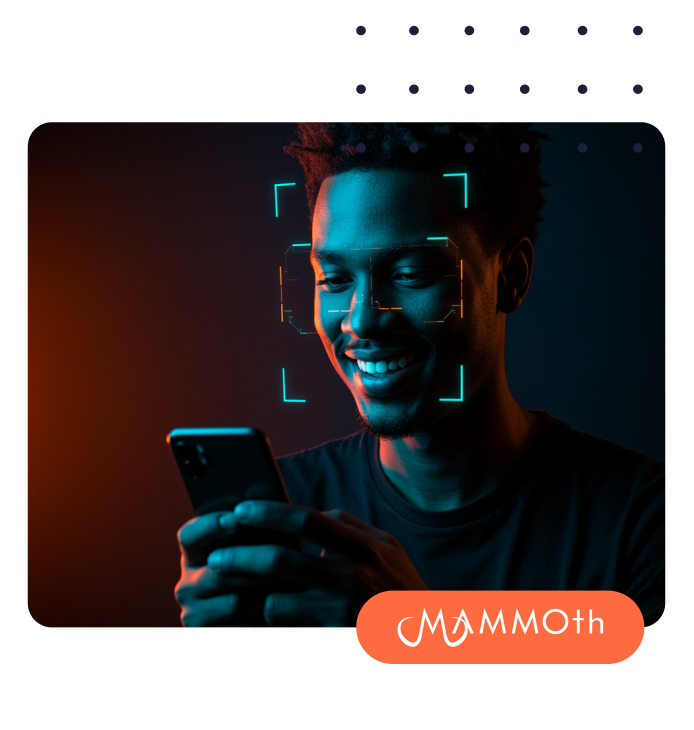What is biometrics?
Biometrics refers to the measurement and analysis of physical characteristics that are unique to each individual. The term comes from Greek and means something like "measurement on living beings". Biometric characteristics can be uniquely assigned to a person because they are individual to and inseparable from each person. This makes biometric identification processes such as automated facial recognition a suitable means of achieving security goals and complying with legal requirements when identifying business partners and customers.
What counts as biometric data?
Biometric features include all physiological characteristics unique to an individual human being. They can be divided into passive and active characteristics. Passive features include static physical characteristics such as facial features, the iris or the fingerprint, but also feature types that are currently less common in security procedures, such as the shape of the ear, individual body odour or the vein patterns on the back of the hand.
Active biometric features, on the other hand, denote actions and actions that are characteristic of a person. These include, for example, the human voice or speech behaviour, the individual hand movement when signing, gestures and facial expressions when speaking, or the stroke rhythm when typing on a keyboard. These active characteristics can, of course, fluctuate and vary depending on the situation. However, they are always based on a physical component, which is why active biometric features can also be understood as an expression of a passive biometric feature.
What is biometric recognition?
Biometric recognition can be divided into two types based on its purpose: Identification is the process of determining a person's identity using physical characteristics. The question "Who is this person?" is answered. This requires a database of reference data for all users against which the measured characteristics can be compared.
Verification or authentication is the process of confirming or refuting a person's identity based on physical characteristics. The question "Is this person really Mr./Mrs. XY?" is answered. Biometric data is used to verify that a person is indeed who they say they are.
What is biometric verification?
A biometric check is a process of uniquely identifying a person by evaluating characteristic biological features. It checks the features on the user's face to compare them to an image on an ID card or passport. Biometric verification is necessary to detect stolen or modified IDs.
What is a biometric check?
A biometric check is a process by which a person can be uniquely identified by evaluating one or more distinguishing biological traits. It is based on face recognition comparison technology and scans the characteristics in the user’s face to compare it to a picture on the ID card or passport. To detect stolen or modified IDs a biometric check is necessary. Biometric Checks are used in a variety of settings, from security gates at airports to time clocks at offices. They can also be used to unlock smartphones and other devices. While Biometric Checks are generally considered to be more secure than traditional methods like passwords, there have been some concerns raised about their privacy implications.
What is a Mobile Biometric Check?
A mobile Biometric Check is an electronic device used to capture and verify someone's identity using their physical characteristics. The most common form of biometric check is a fingerprint scanner, but iris scanners and facial recognition software are also becoming more common. An app for a mobile biometric check (like AutoIdent) uses usually the latest in security and encryption technology to ensure that the captured personal information is safe and secure. Biometric Mobile Check is available for both iOS and Android devices.
Mobile-based biometrics checks are often used in high-security settings where traditional methods like ID cards or passwords may be vulnerable to fraud or theft. Mobile biometrics are particularly useful as they allow for quick and convenient identity verification without the need for a dedicated station or terminal. This makes them ideal for use in busy environments like airports or crowd-controlled events.
What are Biometric Checkers?
Biometric checkers or Online Biometric Checkers can be used by businesses to verify the identity of their employees. By taking a photo of the employee and comparing it to a database of images, the biometric checker can confirm that the person is who they say they are. This can be helpful for businesses that need to ensure that their employees are authorized to access certain areas or information. In addition, biometric checkers can also be used to track employee attendance. By requiring employees to scan their fingerprint or iris before clocking in, businesses can more accurately track who is coming and going. This can be helpful for ensuring that employees are showing up on time and for keeping track of overtime hours. Biometric checkers can provide a number of benefits for businesses, from identity verification to attendance tracking.
How is biometric authentication performed?
The biometric authentication process is used, for example, to verify that a document belongs to the person using it for identification. Usually, a person's facial features are compared with the biometric photo on their ID document. With IDnow Autoident, this works automatically with the help of facial recognition through a selfie check. Alternatively or as a supplement, recognition can be performed by a test using live 3D video to rule out the possibility of recorded videos being used to circumvent biometric identification procedures. Another option or complementary security measure is to match biometric data stored on the chip of ID documents with actual biometrics. This enables companies to reliably identify consumers and comply with the requirements of the German Money Laundering Act (GwG).
While facial recognition is one of the most common uses of biometrics, many other biometric data can also be used: iris verification, fingerprint matching, handwritten signature verification, automated speech recognition and more.
Why is biometric data used for identification?
Biometric identification is playing an increasingly important role in security systems. Other means of authentication such as passwords or security cards - i.e., systems based on knowledge or possession - are assigned to a specific person only intentionally and for a limited time. Physical characteristics, on the other hand, are unchangeable and permanently assignable to a person. This makes biometrics the superior basis for the verification and identification of individuals. Physical characteristics are always available and usable. Unlike passwords and security tokens, they cannot be forgotten or lost. In addition, biometric data is difficult to steal and imitate. This risk is significantly higher in direct comparison with passwords and security tokens.
Last but not least, AI systems are constantly evolving. As a result, biometric technologies are becoming more accurate and reliable. The latest generation of efficient artificial intelligence uses big data to learn to distinguish the details of a human face in the same way that a human can. Also, as camera and sensor technologies continue to evolve, biometric capture is becoming more accurate. 2D, 3D and infrared cameras, as well as the combination of these technologies, enable fast, reliable facial recognition even in difficult lighting conditions.
Read more: Fraud Detection: How Anti-spoofing facial recognition works



